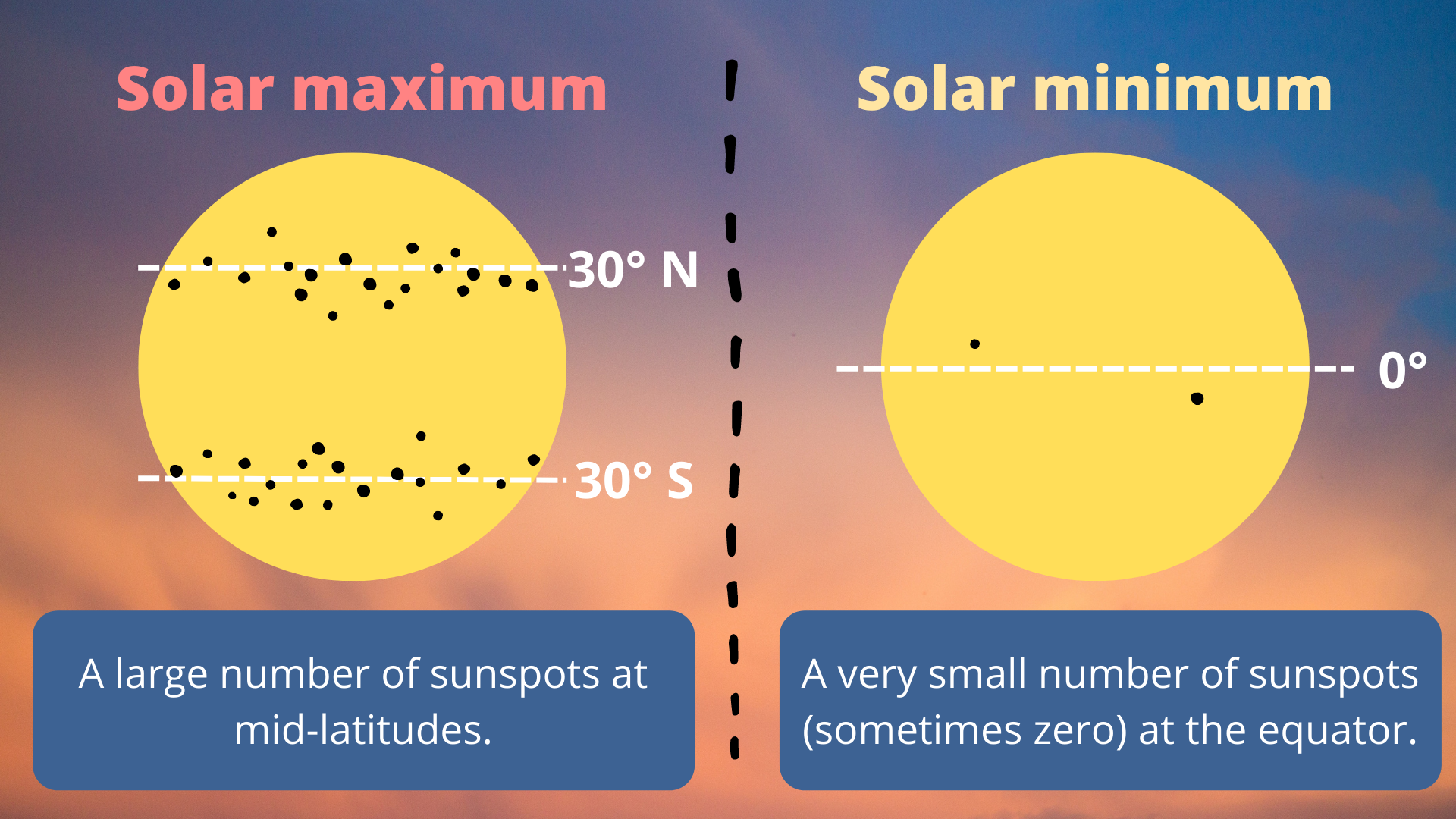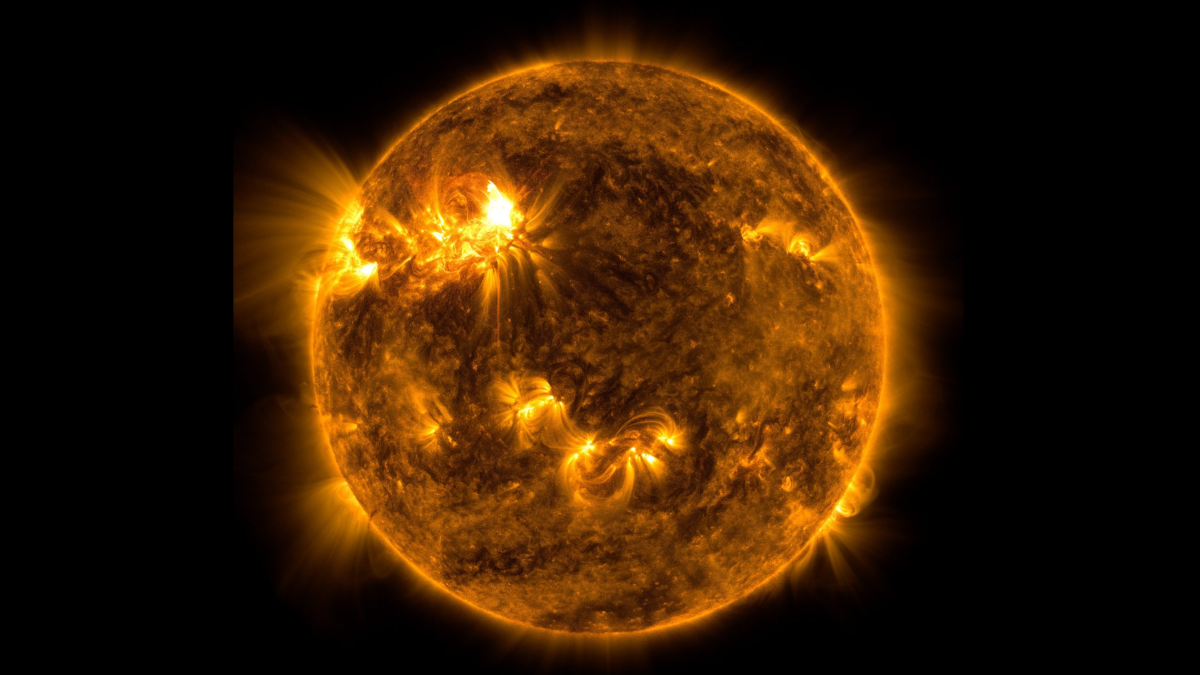Solar cycle: What is it and why does it matter?
We are currently experiencing solar cycle 25.

The solar cycle describes an approximately 11-year cycle of solar activity driven by the sun's magnetic field and indicated by the frequency and intensity of sunspots visible on the surface.
Solar cycles are repetitive yet difficult to predict. A cycle can be as short as eight years or as long as 14 years and varies dramatically in intensity. The current cycle — solar cycle 25 — began in December 2019, according to a solar cycle 25 article from NASA. Solar activity is expected to ramp up until the predicted solar maximum as early as 2024.
Heightened solar activity poses a risk to satellites, spacecraft and even spacewalking astronauts due to increased radiation exposure. On Earth, the large geomagnetic storms that solar activity triggers can interfere with high-frequency radio communications and Global Positioning Systems (GPS), according to NASA.
Related: Solar eclipses: When is the next one?
What causes the solar cycle?
The solar cycle is driven by the sun's magnetic field, according to NASA Space Place. Every 11 years or so, the sun's magnetic field flips so north becomes south and south becomes north. Changes in the sun's magnetic field affect the amount of activity on the solar surface.
In a NASA statement, solar physicist Phil Scherrer of Stanford University describes what happens during the solar cycle. "The sun's polar magnetic fields weaken, go to zero and then emerge again with the opposite polarity. This is a regular part of the solar cycle."
When the sun's magnetic poles flip, the effects ripple through the solar system since the heliosphere — the region of space that is influenced by the solar wind — extends billions of miles or kilometers beyond Pluto according to the statement. Planets without a protective magnetosphere such as Venus feel the full impact. In 2006 the sun ejected a small coronal mass ejection (CME) — a release of plasma and magnetic field — which hit Venus and stripped the planet's atmosphere of vast amounts of oxygen.
Breaking space news, the latest updates on rocket launches, skywatching events and more!
Earth's magnetic poles also flip, but the interval between the reversals is much longer, averaging about every 300,000 years according to NASA Climate. The last pole reversal happened about 780,000 years ago.
Solar cycle and sunspot activity
Sunspots are darker, cooler areas on the surface of the sun that arise due to disturbances in the sun's magnetic field. The total number of sunspots varies during the 11-year solar cycle, with the peak of sunspot activity coinciding with solar maximum and a sunspot hiatus coinciding with solar minimum, according to the Space Weather Prediction Center of the National Oceanic and Atmospheric Administration (NOAA). The solar cycle is also sometimes referred to as the sunspot cycle.
During a solar cycle, the number of sunspots goes from low to high and then back down to low.
The position of sunspots also changes throughout the cycle. During solar maximum, sunspots are found along mid-latitudes (approximately 30 degrees north and 30 degrees south). Then, sunspots gradually move toward the equator, where they are located during solar minimum. Sometimes no sunspots are visible at all during solar minimum.
How does the solar cycle affect us?
When the solar cycle is at peak activity — solar maximum — space weather can pose a risk to communications on Earth, satellites and even spacewalking astronauts.
One spectacular side-effect of increased solar activity during the solar cycle is increased opportunities to see auroras: the aurora borealis (northern lights) and its southern counterpart, the aurora australis. When the energetic particles from the sun slam into and interact with Earth's upper atmosphere, dazzling light shows illuminate the sky. The color of the aurora depends on what chemicals in Earth's atmosphere the particles hit. Red hues are produced from collisions with nitrogen molecules and green is produced by oxygen molecules.
If you're interested in capturing aurora images check out our guide on how to photograph the aurora and our best equipment for aurora photography guide.
Despite the vast amount of energy released from the sun during particularly active periods in its solar cycle, according to NASA, the sun's irradiance — the amount of electromagnetic radiation received from the sun in power per unit area — varies by up to 0.15% across the 11-year solar cycle. This change in irradiance is not large enough to cause any long-term changes to Earth's climate.
According to NASA, there are three main ways heightened solar activity can affect Earth.
Large solar flares can lead to a radio blackout storm on Earth, whereby electromagnetic energy disrupts the Earth's upper atmosphere. This disruption occurs mainly in the ionosphere, where long-distance communications signals travel, and can lead to radio blackouts across the world.
Solar radiation storms can also emit fast-moving charged particles, which carry a lot of energy and can endanger astronauts and Earth-orbiting spacecraft. During these storms, astronauts on the International Space Station may be asked to seek shelter and all extravehicular activities are paused. Radiation-sensitive systems on satellites are powered down until the radiation storm has passed.
One to three days after a solar eruption pointed toward Earth, a giant CME can hit Earth's magnetosphere and induce currents in electrical systems on Earth. Power grids are particularly vulnerable to such surges in energy, which can cause major blackouts. Notable blackouts caused by geomagnetic storms are the 1989 blackout across the entire province of Quebec, Canada and the 2003 blackout across the eastern U.S. and parts of Canada.
How is the solar cycle predicted and monitored?
It is important to predict and monitor solar cycles so that we are prepared for changes in solar activity.
The World Data Center for the Sunspot Index and Long-term Solar Observations at the Royal Observatory of Belgium monitors and predicts the solar cycle, tracking sunspots and recording the highs and lows of the solar cycle. NASA and NOAA scientists also form a regular solar cycle prediction panel to evaluate solar activity.
Understanding the solar cycle and being able to predict when a new cycle will arise is a key part of space weather forecasting.
Scientists hope one day to be able to forecast space weather much like meteorologists do here on Earth.
"There is no bad weather, just bad preparation," Jake Bleacher, chief scientist for NASA's Human Exploration and Operations Mission Directorate at NASA said in the solar cycle 25 article from NASA. "Space weather is what it is — our job is to prepare."
Who discovered the solar cycle?
The solar cycle was discovered by amateur astronomer Heinrich Schwabe during his observations of the sun between 1826 and 1843, according to NASA. Schwabe noticed that sunspot activity changed over approximately 11 years. He also determined that the sun rotates once every 27 days.
Scientists have been numbering solar cycles since 1755. Solar cycle 1 began in March 1755 and ended in June 1766, according to space news website spacetoday.org. We are currently experiencing solar cycle 25.
Additional resources
Check out NOAA's Space Weather Prediction Center (SWPC) for official space weather forecasts for the U.S. Explore more about space weather impacts with NOAA's SWPC. See the solar cycle like never before with this impressive composite image from the Solar and Heliospheric Observatory (SOHO), which shows changes in the sun's appearance over the solar cycle. Read more about how scientists around the world help to track the solar cycle in this article from NASA.
Bibliography
Buis, A., 2021. Flip Flop: Why Variations in Earth's Magnetic Field Aren't Causing Today's Climate Change — Climate Change: Vital Signs of the Planet. [online] Climate Change: Vital Signs of the Planet. [Accessed April 25, 2022].
Gold, A., 2021. Five Questions About Space Weather and Its Effects on Earth, Answered. [online] NASA. [Accessed April 25, 2022].
Jpl.nasa.gov. Space Technology 5. [online] [Accessed April 25, 2022].
NASA. 2020. Solar Storm and Space Weather - Frequently Asked Questions. [online] [Accessed April 25, 2022].
NASA. 2021. FAQ: How Does the Solar Cycle Affect Earth's Climate?. [online] [Accessed April 25, 2022].
Radiowave Propagation & Atmosphere » Electronics Notes. [online] Electronics-notes.com. [Accessed April 25, 2022].
Odenwald, S., 2019. The Day the Sun Brought Darkness. [online] NASA. [Accessed April 25, 2022].
Phillips, T., 2013. The Sun's Magnetic Field is about to Flip. [online] NASA. [Accessed April 25, 2022].
Potter, S., 2021. Solar Cycle 25 Is Here. NASA, NOAA Scientists Explain What That Means. [online] NASA. [Accessed April 25, 2022].
Spaceplace.nasa.gov. 2021. What Is the Solar Cycle? | NASA Space Place — NASA Science for Kids. [online] [Accessed April 25, 2022].
Swpc.noaa.gov. Sunspots and Solar Cycles | NOAA / NWS Space Weather Prediction Center. [online] [Accessed April 25, 2022].
Wwwbis.sidc.be. 2021. SILSO | World Data Center for the production, preservation and dissemination of the international sunspot number. [online] [Accessed April 25, 2022].

Daisy Dobrijevic joined Space.com in February 2022 having previously worked for our sister publication All About Space magazine as a staff writer. Before joining us, Daisy completed an editorial internship with the BBC Sky at Night Magazine and worked at the National Space Centre in Leicester, U.K., where she enjoyed communicating space science to the public. In 2021, Daisy completed a PhD in plant physiology and also holds a Master's in Environmental Science, she is currently based in Nottingham, U.K. Daisy is passionate about all things space, with a penchant for solar activity and space weather. She has a strong interest in astrotourism and loves nothing more than a good northern lights chase!



